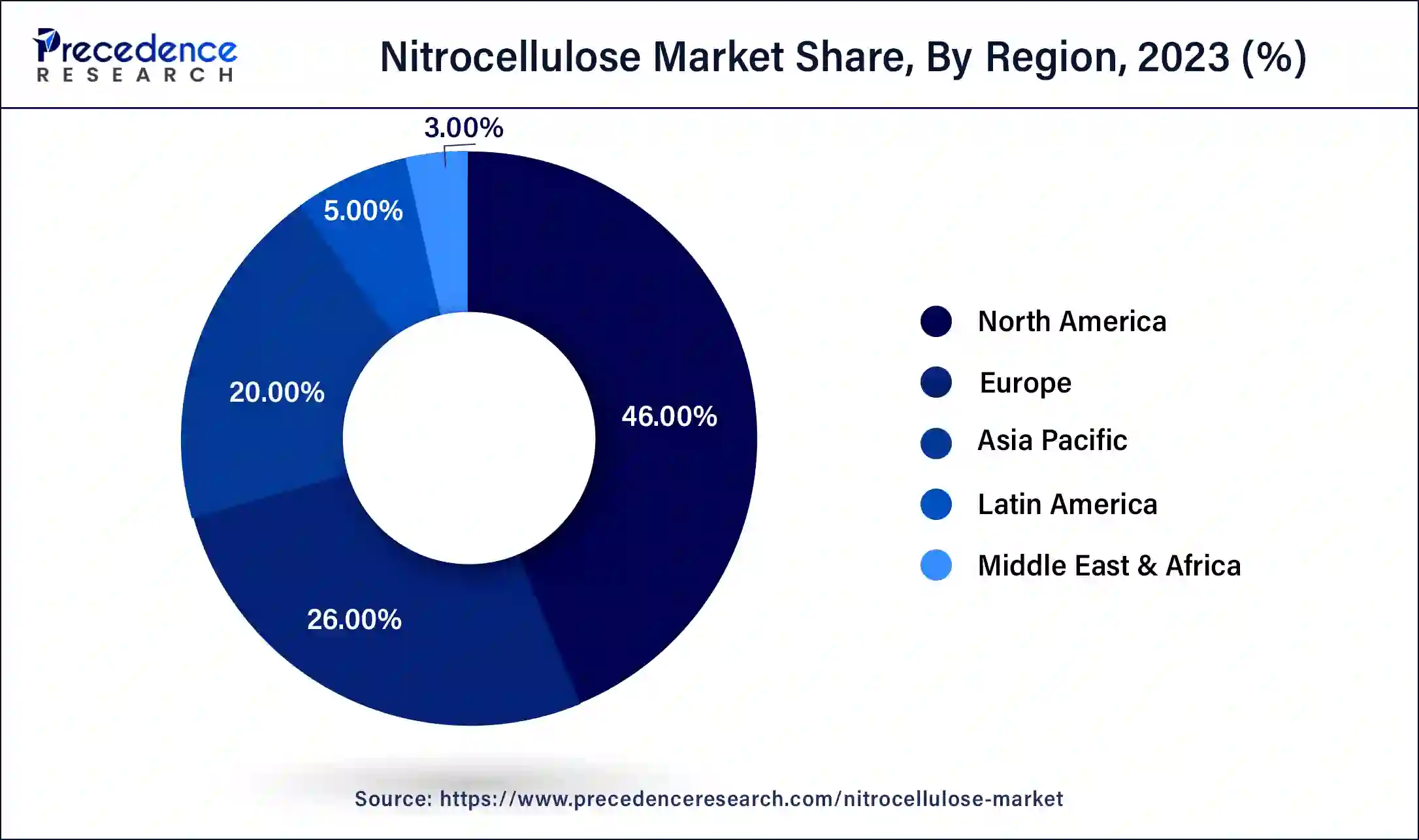Nitrocellulose Market (By Application: Printing Inks, Automotive Paints, Wood Coatings, Leather Finishes, Nail Varnishes, Others) - Global Industry Analysis, Size, Share, Growth, Trends, Regional Outlook, and Forecast 2024-2034
The global nitrocellulose market size was USD 840.12 million in 2023, calculated at USD 881.79 million in 2024 and is expected to reach around USD 1425.65 million by 2034, expanding at a CAGR of 4.92% from 2024 to 2034.

The Asia-Pacific nitrocellulose market size was estimated at USD 386.46 million in 2023 and is projected to surpass around USD 655.80 million by 2034 at a CAGR of 5.10% from 2024 to 2034.

Asia Pacific is indeed a dominant force in the nitrocellulose market, accounting for more than 46% of the market's market share in 2023. Asia Pacific has emerged as a dominant force in the nitrocellulose industry, primarily fueled by the expanding application scope within the paints and coatings sector. Countries such as Thailand, India, and China stand out as key players, boasting substantial production capacities and serving as major exporters of nitrocellulose products. The region benefits from robust trade networks and a thriving market for nitrocellulose due to its extensive utilization across various sectors. In particular, nitrocellulose finds widespread application in the formulation of printing inks, automotive paints, wood coatings, and leather tanning and finishes, among others.
The dynamic economies of Thailand, India, and China drive significant demand for nitrocellulose-based products, both domestically and internationally. Moreover, these countries leverage their manufacturing prowess and strategic geographic locations to cater to global markets, further solidifying Asia Pacific's position as a key player in the nitrocellulose industry. With increasing industrialization, urbanization, and infrastructural development across the region, the demand for paints, coatings, and related products is expected to continue rising, sustaining the growth momentum of the nitrocellulose market in Asia Pacific for the foreseeable future.

North America is also poised for significant growth CAGR in the nitrocellulose market, The North America region, particularly the United States and Canada, is poised to witness a surge in demand for nitrocellulose, driven by several key factors. Firstly, the flourishing tourism sector and robust construction industry in these countries are anticipated to stimulate the demand for wooden items. As tourism activities and construction projects continue to expand, there will be a heightened need for wooden furniture, fixtures, and structures, thereby increasing the demand for nitrocellulose-based coatings used in wooden applications.
Canada, specifically, stands out as the fourth-largest manufacturer of wooden furniture globally, a testament to its significant presence in the wooden products market. The burgeoning smart homes sector in the region, coupled with the rising standard of living, is expected to further bolster the demand for nitrocellulose coatings used in wooden applications.
Furthermore, prominent position as a market leader in the automotive sector contributes to the growth of automotive paints. With a robust automotive industry and the presence of renowned automobile manufacturers, Germany experiences a high demand for automotive paints, including those formulated with nitrocellulose. Hence, the confluence of these factors, including the expansion of the tourism sector, growth in construction activities, and the thriving automotive industry, is expected to drive substantial growth in the demand for nitrocellulose products in North America and Germany.
Nitrocellulose, also known as cellulose nitrate, is a compound derived from cellulose through a process called nitration, which involves treating cellulose with nitric acid or a mixture of nitric acid with other acids like sulfuric and hydrochloric acid. Cellulose, obtained from purified sources such as cotton linters or wood pulp, serves as the precursor for nitrocellulose production. One of the defining characteristics of nitrocellulose is its highly flammable nature, making it a valuable component in various applications requiring explosive or combustible properties. It finds extensive use in rockets, propellants, explosives, and other pyrotechnic applications due to its rapid combustion and energy release properties.
The properties of nitrocellulose can vary based on several factors including the source of cellulose, the duration of the nitration reaction, and the ratio of acid to cellulose used during the process. These variations in manufacturing parameters yield nitrocellulose with differing characteristics suited for specific applications. Apart from its role in explosives and pyrotechnics, the nitrocellulose market also finds utility in other fields. It can be employed in the production of plastic films, where its film-forming properties are beneficial, and in printing inks, where it serves as a binder and provides adhesion to surfaces. Therefore, nitrocellulose stands as a versatile compound with a wide range of applications, owing to its unique chemical properties and adaptability to various industrial processes.
Nitrocellulose Market Data and Statistics
| Report Coverage | Details |
| Global Market Size in 2023 | USD 840.12 Million |
| Global Market Size by 2024 | USD 881.79 Million |
| Global Market Size by 2034 | USD 1425.65 Million |
| Growth Rate from 2024 to 2034 | CAGR of 4.92% |
| Largest Market | Asia Pacific |
| Base Year | 2023 |
| Forecast Period | 2024 to 2034 |
| Segments Covered | Application, and Region |
| Regions Covered | North America, Europe, Asia-Pacific, Latin America, and Middle East & Africa |
Growth of the building and construction sector along with by evolving beauty trends
Nitrocellulose-based wood coatings play a crucial role in the building and construction industry, especially in applications such as sliding doors, windows, furniture decking, and other architectural elements. The growth of the building and construction sector, fueled by urbanization and infrastructure development worldwide, has significantly increased the demand for furniture and other wood products. Nitrocellulose-based wood coatings offer excellent durability, protection, and aesthetic appeal, making them a preferred choice for finishing wooden surfaces in construction projects. Moreover, nitrocellulose is a key ingredient in nail lacquer formulations.
Its exceptional adhesion to natural nails, along with its ability to form a protective yet breathable layer, makes it an essential component in nail varnish applications. With the global cosmetics industry witnessing steady market growth driven by evolving beauty trends, the demand for nail lacquers and coatings is expected to rise correspondingly.
As consumers seek nail products with long-lasting performance and vibrant colors, nitrocellulose remains a preferred choice for nail varnish manufacturers due to its unique properties and performance. Furthermore, nitrocellulose finds extensive use in explosives, particularly in military applications for driving projectiles. Its high energy content and stability make it an ideal component in explosive formulations used by armed forces worldwide. The consistent demand for military-grade explosives for defense and security purposes contributes to the sustained growth of the nitrocellulose market. The convergence of these factors, including the expansion of the building and construction sector, the growth of the cosmetics industry, and the continued demand for military-grade explosives, collectively drive the market growth of the nitrocellulose market.
Additionally, ongoing innovations in nitrocellulose-based formulations, such as improved durability, eco-friendly compositions, and enhanced performance characteristics, further propel market expansion. As industries continue to prioritize product quality, performance, and sustainability, nitrocellulose remains a versatile and indispensable material across various applications, ensuring its continued relevance and growth in diverse sectors globally.
Safety and health concerns associated with nitrocellulose-based manufacturing processes
The use of nitrocellulose dampened with isopropanol in paint and ink manufacturing processes poses significant fire hazards due to the highly flammable nature of these chemicals. Blending machines and stored nitrocellulose are particularly susceptible to fire outbreaks, which can result in severe damage to manufacturing plants and pose risks to personnel safety. Moreover, exposure to high concentrations of solvents like isopropanol can lead to adverse health effects such as dizziness, breathing difficulties, and unconsciousness. Handling strong acids like sulfuric acid, commonly used in industrial processes involving nitrocellulose, also presents hazards to workers. Long-term exposure to these chemicals can result in chronic health issues including kidney and liver damage, central nervous system depression, and permanent eye damage.
Additionally, the decomposition or combustion of nitrocellulose and associated chemicals may release toxic gases such as nitrogen oxides, hydrogen cyanide, and carbon monoxide, further exacerbating health risks for workers and nearby communities. These safety and health concerns associated with nitrocellulose-based manufacturing processes and chemical handling practices are significant factors that can hamper market growth in the market. Compliance with stringent safety regulations and implementation of robust safety protocols are imperative to mitigate these risks and ensure the well-being of workers and environmental protection within manufacturing facilities.
Increasing demand for paints and coatings
The building and construction segment plays a significant role in driving the demand for nitrocellulose, primarily due to its widespread usage in the manufacturing of paints and coatings. These coatings offer numerous advantages such as durability, odorlessness, and hygiene, making them well-suited for various residential and commercial construction applications. Whether it's for walls, doors, windows, or metal structures, nitrocellulose-based paints and coatings provide long-lasting protection and aesthetic appeal with options for both matte and glossy finishes. The increasing demand for paints and coatings in residential areas is fueled by the rising construction activities driven by government initiatives like India's 'Smart City Mission' and 'Housing for All' program. Thereby, the increasing demand for paints and coatings creates a potential opportunity for the nitrocellulose market.
These initiatives are propelling infrastructure development and urbanization, leading to a surge in construction projects and subsequently boosting the demand for nitrocellulose-based coatings. Furthermore, the functional benefits offered by these coatings, such as thermal conduction, light absorption, insulation, anti-skid properties, and reflection, make them highly desirable across various global markets. As construction practices evolve and sustainability becomes a key focus, nitrocellulose-based paints and coatings are expected to witness continued growth and adoption in the building and construction sector worldwide.
The printing inks segment has held a 28% market share in 2023. The printing ink application segment stands as a dominant force within the global nitrocellulose industry, driven by several key factors. Technological advancements have significantly contributed to the segment's growth, facilitating the development of eco-friendly inks that align with evolving environmental regulations and consumer preferences.
One of the primary sectors fueling the demand for printing inks is the packaging and logistics industry. Printing inks play a crucial role in labeling, branding, and product identification across various packaging materials. Additionally, the proliferation of digital printing technologies has propelled the demand for printing inks, particularly in applications such as outdoor signage and inkjet printing. Environmental concerns have emerged as a pivotal driver shaping the printing ink market landscape. Government authorities are increasingly focused on modernizing printing industry standards to minimize environmental impact.
Nitrocellulose-based lamination ink has emerged as a preferred choice in flexography and gravure printing due to its ability to deliver high-quality, vibrant color results while exhibiting strong laminated bond strength. Furthermore, the inherent characteristics of nitrocellulose-based inks, including minimal odor and solvent retention, make them highly desirable in the packaging industry. These attributes contribute to enhanced product quality and consumer satisfaction, driving the adoption of nitrocellulose-based printing inks across various packaging applications. Therefore, the printing ink segment's dominance underscores its pivotal role in diverse industries and its responsiveness to evolving market dynamics, including technological innovations and environmental sustainability initiatives.
The wood coatings segment is anticipated to witness significant growth over the projected period. Wood coatings play a vital role across various applications, ranging from furniture decking to sliding windows and doors, as well as in carpets and coloring for industrial purposes. Nitrocellulose-based lacquers are particularly prevalent in the manufacturing of musical instruments, such as steel strings for guitars, owing to their excellent finishing properties.
In the United States, especially, nitrocellulose lacquer is widely used for its ability to enhance durability and flexibility when combined with other resins. One of the key advantages of nitrocellulose lacquer is its ease of application, which facilitates convenient touch-ups and repairs, making it a preferred choice in the woodworking industry. In the realm of printing inks, those containing cellulose nitrate are witnessing a surge in demand. These inks are prized for their ability to produce graphics with high brilliance and resolution.
Moreover, their compatibility with contemporary printing machines enables fast-printing speeds, contributing to enhanced efficiency in printing operations. As industries continue to prioritize quality and efficiency in their manufacturing processes, the demand for wood coatings and printing inks containing nitrocellulose is expected to persist and grow. The versatility and performance characteristics of nitrocellulose-based products position them as indispensable components in various industrial and creative applications, driving their continued adoption and market expansion.
Segments Covered in the Report
By Application
By Geography
For inquiries regarding discounts, bulk purchases, or customization requests, please contact us at sales@precedenceresearch.com
No cookie-cutter, only authentic analysis – take the 1st step to become a Precedence Research client